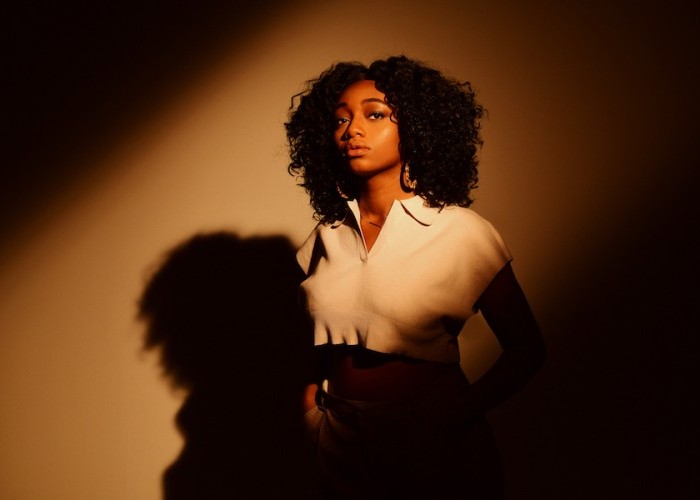Oct 28, 2025 10:47 AM
In Memoriam: Jack DeJohnette, 1942–2025
Jack DeJohnette, a bold and resourceful drummer and NEA Jazz Master who forged a unique vocabulary on the kit over his…

Joy’s heroes range from Cécile McLorin Salvant, Jazzmeia Horn and H.E.R., to Ella Fitzgerald and Sarah Vaughan.
(Photo: Shervin Lainez)Samara Joy is a self-possessed, deeply emotive vocalist, with power that usually takes a lot of living to master. But the Purchase College graduate has got it in spades.
When she spoke to DownBeat via Zoom, Joy was quick to admit, “I haven’t really experienced most of what is talked about in the songs. So, I have to either immerse myself in how my heroes sang them or try to tap into a character and think of a story where I’m in that position.”
She added that she also is comparatively new to the jazz idiom, sharing that her first encounter with jazz was upon her arrival to college, where, as a jazz studies major, she found “so many people that loved the music. And I heard Sarah Vaughan’s version of ‘Lover Man,’ Live From Sweden, and that was it for me as far as being connected to it.”
In the wake of that connection, Joy found herself surprised that it took so long to encounter the music in a meaningful way, yet once she dove in, she found herself energized by it. “Being an African-American woman — and to have this amazing art form that was created by Black people — and I didn’t know anything about it until I was 18, it was exciting. It was a challenge. It was beautiful. And I’m really grateful to have been connected to it and gotten this far singing it.”
Joy looks up to contemporary artists like Cécile McLorin Salvant, Jazzmeia Horn and even H.E.R., but her heroes also include Ella Fitzgerald and Sarah Vaughan. In fact, Joy won the Sarah Vaughan International Jazz Vocal Competition in 2019, and her study of both Vaughan and Fitzgerald is apparent in her self-titled debut album, which reflects her novel, contemporary-leaning approach to gilded, and sometimes obscure, jazz material.
The treatment of heirloom material recorded for Samara Joy is refreshingly stripped back: Dominated by Pasquale Grasso’s gorgeous guitar and her voice, listeners are compelled to focus on the purity of her tone and the purity of the music. This is particularly true of her interpretations of “Lover Man” and “Jim.” The better known of the two compositions, “Lover Man,” was selected as an homage to her entry into jazz.
Meanwhile, she chose the lesser-known “Jim,” which, like “Lover Man,” was recorded by both Vaughan and Billie Holiday, because she was attracted to the universal nature of the subject matter. Joy explained that it’s about “somebody who doesn’t really care, who doesn’t put any effort into the relationship. And yet, I still can’t help the way I feel toward that person. I’ve seen a lot of romantic comedy, so maybe that’s why, but at one point or another, we have that one person that we care so deeply about.”
Her version of “Stardust” is reminiscent of Nat “King” Cole’s dreamy take on the Hoagy Carmichael standard. And although she says she listened to Cole’s 1957 version, her pathway toward recording the composition was in consequence of hearing Louis Armstrong’s much earlier recording, to which she was immediately attracted.
“I loved it!” she gushed. “I loved it because [of] the way that he played around with the phrasing of the song.”
In due course, Joy hopes her first album will help carry on the tradition. “These are still my heroes that I’m listening to and learning from,” she said. “I’ll always be a student of it while also adding my own perspective.”
Joy also hopes that the album can be a bridge to introduce the music to “people who have never heard jazz before in their life, can appreciate the songs, can appreciate the story behind the songs and relate to them.”
She already has ideas for her second full-length offering. “There’s the standard ‘Out Of Nowhere,’ but there’s also a contrafact called ‘Nostalgia.’ I wrote lyrics for that for a course that I took, and I really liked it. I wrote lyrics for this recording of a funky blues with Charlie Parker, Johnny Hodges and Benny Carter. I wrote lyrics for all their solos as well as for the head. And I realized that I really enjoyed doing that. So, maybe you’ll hear some of that.” DB

Jack DeJohnette boasted a musical resume that was as long as it was fearsome.
Oct 28, 2025 10:47 AM
Jack DeJohnette, a bold and resourceful drummer and NEA Jazz Master who forged a unique vocabulary on the kit over his…

Goodwin was one of the most acclaimed, successful and influential jazz musicians of his generation.
Dec 9, 2025 12:28 PM
Gordon Goodwin, an award-winning saxophonist, pianist, bandleader, composer and arranger, died Dec. 8 in Los Angeles.…

Flea has returned to his first instrument — the trumpet — and assembled a dream band of jazz musicians to record a new album.
Dec 2, 2025 2:01 AM
After a nearly five-decade career as one of his generation’s defining rock bassists, Flea has returned to his first…

To see the complete list of nominations for the 2026 Grammy Awards, go to grammy.com.
Nov 11, 2025 12:35 PM
The nominations for the 2026 Grammy Awards are in, with plenty to smile about for the worlds of jazz, blues and beyond.…

Nov 13, 2025 10:00 AM
For results of DownBeat’s 90th Annual Readers Poll, complete with feature articles from our December 2025 issue,…







